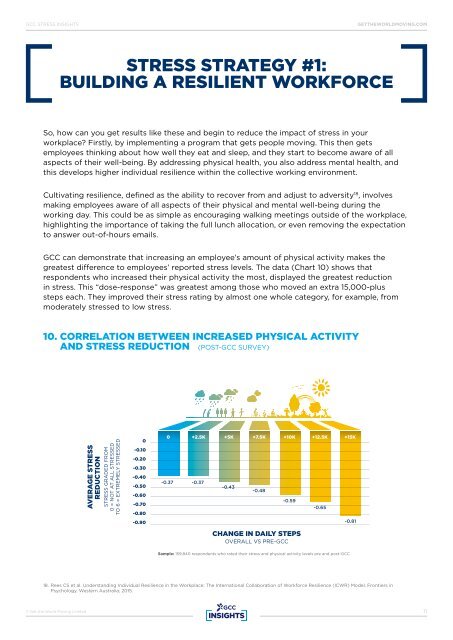GCC-Insights-Stress-Report
GCC-Insights-Stress-Report
GCC-Insights-Stress-Report
You also want an ePaper? Increase the reach of your titles
YUMPU automatically turns print PDFs into web optimized ePapers that Google loves.
<strong>GCC</strong> STRESS INSIGHTS<br />
GETTHEWORLDMOVING.COM<br />
STRESS STRATEGY #1:<br />
BUILDING A RESILIENT WORKFORCE<br />
So, how can you get results like these and begin to reduce the impact of stress in your<br />
workplace? Firstly, by implementing a program that gets people moving. This then gets<br />
employees thinking about how well they eat and sleep, and they start to become aware of all<br />
aspects of their well-being. By addressing physical health, you also address mental health, and<br />
this develops higher individual resilience within the collective working environment.<br />
Cultivating resilience, defined as the ability to recover from and adjust to adversity 18 , involves<br />
making employees aware of all aspects of their physical and mental well-being during the<br />
working day. This could be as simple as encouraging walking meetings outside of the workplace,<br />
highlighting the importance of taking the full lunch allocation, or even removing the expectation<br />
to answer out-of-hours emails.<br />
<strong>GCC</strong> can demonstrate that increasing an employee’s amount of physical activity makes the<br />
greatest difference to employees’ reported stress levels. The data (Chart 10) shows that<br />
respondents who increased their physical activity the most, displayed the greatest reduction<br />
in stress. This “dose-response” was greatest among those who moved an extra 15,000-plus<br />
steps each. They improved their stress rating by almost one whole category, for example, from<br />
moderately stressed to low stress.<br />
10. CORRELATION BETWEEN INCREASED PHYSICAL ACTIVITY<br />
AND STRESS REDUCTION (POST-<strong>GCC</strong> SURVEY)<br />
AVERAGE STRESS<br />
REDUCTION<br />
STRESS GRADED FROM<br />
0 = NOT AT ALL STRESSED<br />
TO 6 = EXTREMELY STRESSED<br />
0<br />
-0.10<br />
-0.20<br />
-0.30<br />
-0.40<br />
-0.50<br />
-0.60<br />
-0.70<br />
-0.80<br />
-0.90<br />
0<br />
-0.37<br />
+2.5K +5K +7.5K +10K +12.5K +15K<br />
-0.37<br />
-0.43<br />
-0.48<br />
-0.59<br />
-0.65<br />
-0.81<br />
CHANGE IN DAILY STEPS<br />
OVERALL VS PRE-<strong>GCC</strong><br />
Sample: 159,840 respondents who rated their stress and physical activity levels pre and post-<strong>GCC</strong><br />
18. Rees CS et al. Understanding Individual Resilience in the Workplace: The International Collaboration of Workforce Resilience (ICWR) Model. Frontiers in<br />
Psychology. Western Australia; 2015.<br />
© Get the World Moving Limited<br />
11


